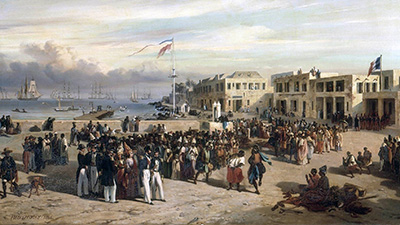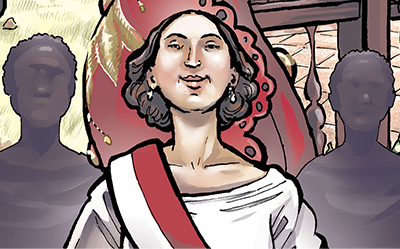An Age of Revolution?
Driving Question: How revolutionary were the Atlantic revolutions?
The Age of Revolution extended beyond America and France, and many types of people participated. In this lesson, we’ll meet the women and the enslaved and colonized people who fought for or were affected by revolutions around the world.
Learning Objectives:
- Evaluate the narrative of the Age of Revolution by examining the roles of women, enslaved people, and colonial subjects during this period.
- Analyze the causes and consequences of the Haitian Revolution and Pueblo Revolt.
- Use a graphic biography to support, extend, or challenge the overarching narratives from this period.
Vocab Terms:
- abolish
- colony
- enslave
- liberation
- oppression
- plantation
- reform
- slavery
Opener: An Age of Revolution?
To teach this lesson step, refer to page 2 of the Lesson 2.5 Teaching Guide.
This activity has a few more layers than a traditional opener. If you want to modify it for your classroom, check out our Differentiation Guide for support.
The view of the Age of Revolution changes depending on whose perspective we adopt. Consider how different people experienced revolutionary events.
Sugar, Flame, and Broken Chains
Revolutionaries, Robots, and Rock-and-Roll:
- Students work with an AI to select three revolutionaries from the long nineteenth century.
- Next, they prompt the AI to help them write lyrics for a song that addresses issues important to each band member.
- Finally, students refining their AI prompts to improve the lyrics.
Why this rocks: Focusing on issues that revolutionaries would most want to sing about will deepen students’ understanding of the motivations behind revolutions while also refining their prompt-writing skills.
The Haitian Revolution has been called the most revolutionary of the Atlantic revolutions. In this video and activity, you’ll explore why.
-
Guiding Questions
-
Before you watch
Preview the questions below, and then review the transcript.
While you watch
Look for answers to these questions:
- What were the main social classes in Saint-Domingue, and why was this social pyramid unstable?
- What was life like for an enslaved person in Saint-Domingue?
- What was the goal of the revolutionaries in the revolution’s early days?
- Who was Toussaint Louverture, and why did he fight first with the Spanish and then with the French?
- How did enslaved people learn about revolutionary ideas?
After you watch
Respond to this question: This video makes the argument that the Haitian Revolution was the most radical of the Atlantic revolutions. Do you agree?
Key Ideas
Expanding the Age of Revolutions
To teach this lesson step, refer to page 6 of the Lesson 2.5 Teaching Guide.
This blog post offers deeper insight into how to effectively teach historical comparison in your classroom.
Revolutionary movements erupted in many places beyond America and France. Use the materials below to evaluate whether these are part of the same narrative.
-
Guiding Questions
-
Before you watch
Preview the questions below, and then review the transcript.
While you watch
Look for answers to these questions:
- Why did the Spanish decide to invade New Mexico and what were some of the immediate consequences of the decision?
- What are some examples of how Pueblo people experienced colonization?
- What are some of the ways that Pueblo people resisted Spanish colonization before 1680?
- What big event sparked the Pueblo Revolt?
- How did the Pueblos coordinate the revolt? Was it successful?
After you watch
Respond to these questions: In what ways does the Pueblo Revolt fit the pattern of other revolutions you’ve learned about? In what ways does it stand out?
Key Ideas
-
Guiding Questions
-
Before you read
Preview the questions below, and then skim the article. Be sure to look at the section headings and any images.
While you read
Look for answers to these questions:
- When did ‘Uthman dan Fodio’s revolution take place in northern Nigeria? What other revolutions in the Atlantic world were taking place around this time?
- What economic factors led to revolutions in West Africa?
- What was the ideology or unifying force for revolution in West Africa?
- What revolutionary state did ‘Uthman dan Fodio create? How revolutionary was this state?
After you read
Respond to this question: Would you include these West African revolutions as part of the Atlantic revolutions?
Daughters of Revolution
To teach this lesson step, refer to page 9 of the Lesson 2.5 Teaching Guide.
Read this blog post for some words of wisdom from an experienced teacher about using the Revolutionary Women activity.
Though revolutionary narratives are often centered on founding fathers, plenty of women played central roles in defining the Age of Revolution.
-
Guiding Questions
-
Before you read
Preview the questions below, and then skim the comic, paying attention to things like prominent colors, shapes, and types of text and fonts. How do you know where to start and in which direction to read? What’s in the gutters (the space between panels)? Who or what is the focus of the comic?
While you read
- How did Sáenz’s father try to teach her to be obedient? What was the result?
- Who were Sáenz’s companions? Why don’t we know a lot about them?
- How did Manuela Sáenz, Jonotas, and Natan serve Simón Bolívar and the revolutionaries?
- How does the artist show Sáenz’s attempt to break out of confinement using art?
- How does the artist portray Jonotas and Natan? Why does she make this choice?
After you read
Respond to this question: How does this biography of Manuela Sáenz support, extend, or challenge what you have learned about social transformations and their limits during the long nineteenth century?
Closer: An Age of Revolution?
To teach this lesson step, refer to page 13 of the Lesson 2.5 Teaching Guide.
Some revolutions get all the attention. But were the big names really the most revolutionary?
Writing: Political Revolutions
To teach this lesson step, refer to page 13 of the Lesson 2.5 Teaching Guide.
Check out our Assessment Guide and Writing Guide to prepare students to take on the challenge of writing a DBQ response.
Analyze these documents describing the political revolutions of the long nineteenth century. Then, build an argument detailing the most significant causes of political revolutions during this time period.







